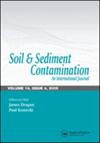Using applied research to reduce uncertainty in health risk assessment: Five case studies involving human exposure to chromium in soil and groundwater
IF 1.5
4区 环境科学与生态学
Q4 ENVIRONMENTAL SCIENCES
引用次数: 7
Abstract
In this article, five case studies are presented that involve original research conducted in order to better understand the potential health risks associated with human exposure to Cr(VI) in soils and groundwater. Each study was designed to address a specific data gap, and all of these studies involved the use of human volunteers and/or the study of human biological fluids. The results of this research can be summarized as follows: (1) soil concentrations of approximately 1240 ppm Cr(VI) or less do not elicit allergic contact dermatitis (ACD) in a vast majority of the general population (>99.9%), and soil concentrations much higher than this value are also health protective if the Cr(VI) is not readily bioavailable; (2) exposure to soil concentrations up to 400 ppm total chromium is unlikely to influence urinary chromium levels; (3) the human gastrointestinal tract can reduce ingested Cr(VI) to Cr(III) at concentrations up to 10 mg Cr(VI)/1; and (4) at water concentrations of up to approximately 22 mg Cr(...利用应用研究减少健康风险评估中的不确定性:涉及人类接触土壤和地下水中的铬的五个案例研究
在本文中,介绍了五个案例研究,这些研究涉及为更好地了解与人类接触土壤和地下水中的铬(六)有关的潜在健康风险而进行的原始研究。每项研究都是为了解决特定的数据缺口而设计的,所有这些研究都涉及使用人类志愿者和/或研究人类生物液体。结果表明:(1)土壤中Cr(VI)浓度约为1240 ppm或更低不会引起绝大多数人群(99.9%)的过敏性接触性皮炎(ACD),如果Cr(VI)不容易被生物利用,则土壤浓度远高于此值也具有保护作用;(2)接触总铬浓度高达400ppm的土壤不太可能影响尿铬水平;(3)人体胃肠道可将摄入的Cr(VI)降低为Cr(III),浓度高达10 mg Cr(VI)/1;(4)水的浓度高达约22毫克铬(…
本文章由计算机程序翻译,如有差异,请以英文原文为准。
求助全文
约1分钟内获得全文
求助全文
来源期刊

Soil & Sediment Contamination
环境科学-环境科学
CiteScore
4.20
自引率
10.00%
发文量
53
审稿时长
2.2 months
期刊介绍:
When it comes to assessing and mitigating contaminated soils and sediments, there is no substitute for having the very latest tools, techniques and methodologies at your fingertips to help you deal with these issues efficiently and cost-effectively.
This is just the kind of essential expertise you’ll only find in Soil and Sediment Contamination . This internationally, peer-reviewed publication focuses on soil and sediment contamination from:
-Sludges-
Petroleum-
Petrochemicals-
Chlorinated hydrocarbons-
Pesticides-
Lead and other heavy metals.
Get detailed descriptions of all the latest and most efficient offsite and in situ remediation techniques, strategies for assessing health effects and hazards, and tips for dealing with everyday regulatory and legal issues. With the state-of-the-art tools that Soil and Sediment Contamination provides, you can successfully assess, mitigate, and solve both rural and urban soil contamination problems as efficiently and economically as possible.
 求助内容:
求助内容: 应助结果提醒方式:
应助结果提醒方式:


